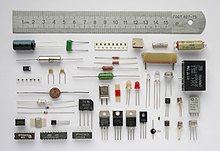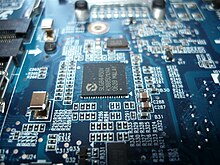Electronic engineering
Electronics engineering, or electronic engineering, is an engineering discipline where non-linear and active electrical components such as electron tubes, and semiconductor devices, especially transistors, diodes and integrated circuits, are utilized to design electronic circuits, devices and systems, typically also including passive electrical components and based on printed circuit boards. The term denotes a broad engineering field that covers important subfields such as analog electronics, digital electronics, consumer electronics, embedded systems and power electronics. Electronics engineering deals with implementation of applications, principles and algorithms developed within many related fields, for example solid-state physics, radio engineering, telecommunications, control systems, signal processing, systems engineering, computer engineering, instrumentation engineering, electric power control, robotics, and many others.[1][verification needed]
The Institute of Electrical and Electronics Engineers (IEEE) is one of the most important and influential organizations for electronics engineers.
Contents
Relationship to electrical engineering
Electronics is a subfield within the wider electrical engineering academic subject. An academic degree with a major in electronics engineering can be acquired from some universities, while other universities use electrical engineering as the subject. The term electrical engineer is still used in the academic world to include electronic engineers.[2] However, some people consider the term 'electrical engineer' should be reserved for those having specialized in power and heavy current or high voltage engineering, while others consider that power is just one subset of electrical engineering and (and indeed the term 'power engineering' is used in that industry) as well as 'electrical distribution engineering'. Again, in recent years there has been a growth of new separate-entry degree courses such as 'information engineering', 'systems engineering' and 'communication systems engineering', often followed by academic departments of similar name, which are typically not considered as subfields of electronics engineering but of electrical engineering.[3][4]Beginning in the 1980s, the term computer engineer was often used to refer to a subfield of electronic or information engineers. However, computer engineering is now considered a subset of electronics engineering and computer science and the term is now becoming archaic.[5]
History
Main article: History of electronic engineering
Electronic engineering as a profession sprang from technological improvements in the telegraph industry in the late 19th century and the radio and the telephone
industries in the early 20th century. People were attracted to radio by
the technical fascination it inspired, first in receiving and then in
transmitting. Many who went into broadcasting in the 1920s were only
'amateurs' in the period before World War I.[6]To a large extent, the modern discipline of electronic engineering was born out of telephone, radio, and television equipment development and the large amount of electronic systems development during World War II of radar, sonar, communication systems, and advanced munitions and weapon systems. In the interwar years, the subject was known as radio engineering and it was only in the late 1950s that the term electronic engineering started to emerge.[7]
Electronics
Main article: Electronics
In the field of electronic engineering, engineers design and test circuits that use the electromagnetic properties of electrical components such as resistors, capacitors, inductors, diodes and transistors to achieve a particular functionality. The tuner circuit, which allows the user of a radio to filter out all but a single station, is just one example of such a circuit.In designing an integrated circuit, electronics engineers first construct circuit schematics that specify the electrical components and describe the interconnections between them. When completed, VLSI engineers convert the schematics into actual layouts, which map the layers of various conductor and semiconductor materials needed to construct the circuit. The conversion from schematics to layouts can be done by software (see electronic design automation) but very often requires human fine-tuning to decrease space and power consumption. Once the layout is complete, it can be sent to a fabrication plant for manufacturing.
Integrated circuits and other electrical components can then be assembled on printed circuit boards to form more complicated circuits. Today, printed circuit boards are found in most electronic devices including televisions, computers and audio players.[8]
Subfields
Electronic engineering has many subfields. This section describes some of the most popular subfields in electronic engineering; although there are engineers who focus exclusively on one subfield, there are also many who focus on a combination of subfields.Signal processing deals with the analysis and manipulation of signals. Signals can be either analog, in which case the signal varies continuously according to the information, or digital, in which case the signal varies according to a series of discrete values representing the information.
For analog signals, signal processing may involve the amplification and filtering of audio signals for audio equipment or the modulation and demodulation of signals for telecommunications. For digital signals, signal processing may involve the compression, error checking and error detection of digital signals.
Telecommunications engineering deals with the transmission of information across a channel such as a co-axial cable, optical fiber or free space.
Transmissions across free space require information to be encoded in a carrier wave in order to shift the information to a carrier frequency suitable for transmission, this is known as modulation. Popular analog modulation techniques include amplitude modulation and frequency modulation. The choice of modulation affects the cost and performance of a system and these two factors must be balanced carefully by the engineer.
Once the transmission characteristics of a system are determined, telecommunication engineers design the transmitters and receivers needed for such systems. These two are sometimes combined to form a two-way communication device known as a transceiver. A key consideration in the design of transmitters is their power consumption as this is closely related to their signal strength. If the signal strength of a transmitter is insufficient the signal's information will be corrupted by noise.
Control engineering has a wide range of applications from the flight and propulsion systems of commercial airplanes to the cruise control present in many modern cars. It also plays an important role in industrial automation.
Control engineers often utilize feedback when designing control systems. For example, in a car with cruise control the vehicle's speed is continuously monitored and fed back to the system which adjusts the engine's power output accordingly. Where there is regular feedback, control theory can be used to determine how the system responds to such feedback.
Instrumentation engineering deals with the design of devices to measure physical quantities such as pressure, flow and temperature. These devices are known as instrumentation.
The design of such instrumentation requires a good understanding of physics that often extends beyond electromagnetic theory. For example, radar guns use the Doppler effect to measure the speed of oncoming vehicles. Similarly, thermocouples use the Peltier-Seebeck effect to measure the temperature difference between two points.
Often instrumentation is not used by itself, but instead as the sensors of larger electrical systems. For example, a thermocouple might be used to help ensure a furnace's temperature remains constant. For this reason, instrumentation engineering is often viewed as the counterpart of control engineering.
Computer engineering deals with the design of computers and computer systems. This may involve the design of new computer hardware, the design of PDAs or the use of computers to control an industrial plant. Development of embedded systems—systems made for specific tasks (e.g., mobile phones)—is also included in this field. This field includes the micro controller and its applications. Computer engineers may also work on a system's software. However, the design of complex software systems is often the domain of software engineering, which is usually considered a separate discipline.
VLSI Design Engineering VLSI stands for very large scale integration. It deals with fabrication of ICs and various electronics components.


No comments:
Post a Comment
its cool